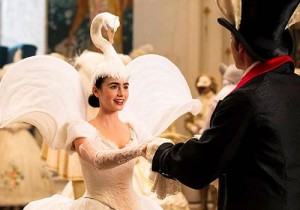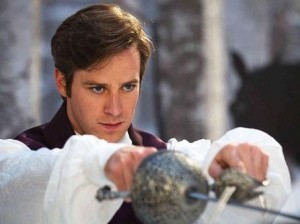Interview: Lily Collins of “Mirror Mirror”
Posted on March 29, 2012 at 8:01 am
Lily Collins was so gracious I felt I really was talking to a fairy tale princess. The daughter of rocker Phil Collins appeared in “The Blind Side” and this joyous, gorgeously re-imagined updating of “Snow White” is her first starring role. She talked to me about learning how to sword-fight and her favorite advice about acting.
We have to talk about the swan dress.
I know, the head and the wings were just the most beautiful little accompaniment to the outfit…I would forget, though, that I had them both on, and I would go to squeeze by people and forget that my span was much longer and I would sometimes knock things over with them, but they were so beautiful and intricately made, so delicate and absolutely like pieces of art, they were an honor to wear.
How does it make you feel different to look at yourself fin the mirror and see that?
Well, it definitely helps get into character when you’re wearing a corset everyday, you truly do feel like the character, it makes all the difference in the world. But also, they were so emblematic of who Snow was—and in the tone of the movie it just amped up the feeling of the film..
The sword fights are amazing! Tell me what kind of training you did and what that was like.
Armie Hammer and I trained including during the filming for about four months. It was very intense, lots of sweating and bruises, but it was so much fun and I had never imagined that I would get to do something like that before.
This is the first time we’ve seen him in a comic role.
He’s hilarious! He’s kind of the perfect mixture of being goofy and aloof in the role, as well as being a gentleman, totally regal, and very, very humble. Armie is, as a person as well, just kind of great mixture of all these different attributes. Most of all, I didn’t realize how much of a jokester and how funny he is, he can make you laugh at the top of the hat.
What was the biggest challenge of filming for you?
I’d never done a film a big as this before, or worked as many hours as I did—and I think it was just making sure I maintained that balance of work and being able to rest and take care of myself, because I did do so many different new things on this film, and I was in a foreign place and on my own there, and it was really just making sure I kept a defined balance between having my time to be myself as well as the character.
This is a very different version of Snow White than we’ve seen before, and not just different in the plotline, but a very different version of the characters. So if her name was Snow Jones, who is she and how did you imagine her?
I really wanted to play her, not as a caricature of a fairy tale princess or as an animated character; I wanted to make her a real girl who was feisty, and who really was passionate, and learned throughout the process that she went through with the dwarfs and experiencing new things, she learned to believe in herself and found that it was what was inside her that made her able to conquer her dreams and go after what she believed in. Never once does she look in the mirror herself, because she’s never aware of what her beauty means, or that she is even as beautiful as everyone says she is. It was really what she found within herself through her new friends and experiences. So, I think she was someone who was very open to spontaneity and life and love, and someone who wasn’t afraid to get a little dirty at times, to go and fight, be on par with the prince and not allow the fact that she was a girl change anything.
I was very touched by the scene near the beginning where you leave the palace for the first time.. The look on your face was so radiant and luminous, and you became aware for the first time what was out there. Tell me a little bit about your process, what was it that you were thinking and how did you achieve that?
I try to put myself in the shoes of whatever character I’m playing and I guess I just imagine the idea of really what it would be like if I was locked away and not allowed to go out and really had the courage to step outside my comfort zone, and experience what was outside of the castle. I thought about the idea of meeting a man for the first time and how it kind of made me feel something other than what I was used to, and the idea of being shocked at the reality of a situation, not really knowing was evil was, because Snow was kept away so long that she doesn’t really see what evil is. So when she goes through the village for the first time, she’s so genuinely hurt by it that she can’t help but show her sadness and kind of the inner-child quality of pure disappointment and confusion. So, I try to just put myself in the character’s shoes, and because it’s the beginning of the story, she’s still very much a child in that sense, seeing everything for the first time. I think of how a child would react—children react in such a genuine way and they don’t think, really, how their reactions are going to affect people, they just let it come out; that’s how she was at the beginning.
What was the best advice that you got about acting?
To remember that you are playing someone other than yourself, and so when taking on a role, of course, it’s you taking on a role, so you’re going to add a bit of yourself, but it’s okay to separate your own beliefs and your own characteristics from this character, because that’s what acting is—you’re taking on another role. If you’re going to go for it, go for it, and dedicate yourself 100% to something, because if you’re fully in a character and you go for it, there’s nothing like feeling that feeling of accomplishing, something as someone else, if you’re really going to be a part of the story and be a different character, you should put your whole heart and soul into it, because once you’re dedicated to it, it really comes across.









